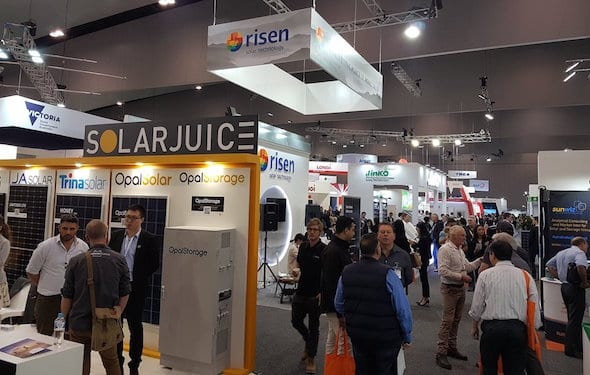Like being a kid in a candy shop – if that candy shop is filled with solar panels, batteries and inverters #AllEnergyAU #somanytoys pic.twitter.com/sN5bUiBqZT
— Clean Energy Council (@cleannrgcouncil) October 11, 2017
Australian energy politics might have reached peak stupid, but Australia’s energy revolution – led by innovators and incumbents alike, all focused on delivering smarter, cheaper power – is just hitting its stride. And consumers are getting into it.
At least, that is the feeling at this year’s All-Energy Australia. In its second day at the Melbourne Convention and Exhibition Centre, the conference has attracted record crowds of more than 6,000 people* and almost 200 exhibitors.
The conference projects a sense of unstoppable momentum, underscored by this year’s record solar PV installation rates, booming interest in battery storage and the leaps and bounds made in smart technology and software platforms that are being masterminded by a growing number of “Internet of Things” start-ups.
And at the centre of it all is the consumer: Australian households and businesses demanding access to the technologies they now know can deliver cheaper power bills and even a more reliable energy supply than what they are getting now.
So while federal government politicians claim climate change is a good thing, and conservative columnists pedal wild conspiracy theories about new smart grid technologies, everyone else is just getting on with it.
PV manufacturers like Jinko Solar, Canadian Solar, Trina, and LONGi Solar are working hard to keep up with renewed demand, as Australian homes and businesses pile into solar PV – commercial solar has accounted for 50 per cent of new capacity installed (by MW) in Australia so far this year.
Even energy market incumbents – like gen-tailer Energy Australia, a surprise new entry among exhibitors at All-Energy this year – are working the floor, keen to show their commitment to a smarter grid and enabling smarter consumers.
Battery giants – including German-based Sonnen, and Chinese battery and EV maker BYD – mingle with up and coming battery technologies like Senec, Simpliphi and Australia’s Ecoult.
While others major industry players, like Fronius, SolarEdge and Enphase, have focussed their inverter technology on helping consumers to maximise solar consumption, and efficient use of grid energy.
Even Chinese mobile phone giant Huawei has a stall, showing off its own flash new inverter – the brains behind solar and storage – and offering, by its very presence here, a powerful example of the direction the industry is now taking.
“When I got into the industry, in… around 2005, it was all about love for the industry. Love for the products that were being built, and those related functionalities,” says Phil Livingston, the head of Redback Technologies.
“Now, it just makes economic sense.”
Redback has just released its second generation home energy management and battery storage system, and on Thursday won another $6 million in finance from the CEFC to help roll it out.
“It doesn’t so much matter what regulatory policy is now,” Livingston added, in an interview with RenewEconomy on the sidelines of the conference.
“It’s going to be hard …to get into the way of the flood. Even with subsidies that directly provide benefit to fossil (fuel) generators.
“For us, it’s all about being more useful for the consumer, building a suite of projects that are intelligence-led.
“What we are doing, effectively, is building the intelligence that allows these networks to really grapple with the real problems in their networks, by understanding what those problems really are,” Livingston said.
“To be frank, with batteries (prices) falling the way they are, I think that the government needs to get on board, as a means of self-preservation, more than anything.”
Across the other end of the vast exhibition hall, Chris Parratt, who heads up Sonnen Australia, says there’s still a way to go for his company – a leading battery seller in Europe – in the Australian market; even despite it being “the place to be” for home battery storage.
“There’s a lot of potential with (Australian) energy prices and our wealth and our usage of energy is very high. To the Germans we look very silly (for) how much energy we use,” Parratt told RE.
“Solar’s doing really well this year… despite the politicians. Battery storage …I think is right at the beginning. Australia is definitely seen as the number one growth place.”
For Canberra-based company, Reposit Power, the name of the game has become increasingly clear:
“It’s about embracing the abundance of renewables and allowing technology to manage that,” said Reposit founder and CEO Dean Spaccavento at a panel discussion at All-Energy on Thursday.
“What (consumers) do want, from what we can tell, is comfort; in that they want to live in their home and not think about what it is that makes their home good to live in – it just wants to be good to live in,” he said.
So how can we speed the transition to a smarter, cheaper grid? Would – as one audience member wondered – a summer of blackouts help move things along?
“No way, absolutely not,” said Spaccavento.
And Stefan Jarnason – CEO of smart solar software company Solar Analytics – was quick to explain.
“What that drives, is politicians to make stupid policy,” he told the conference. “And what I think we can unanimously say, is that we would like politicians to be quiet.”
*This article has been updated to correct the reported number of people who attended this year’s All-Energy Australia conference.










